 GENIO POPVLI ROMANI
GENIO POPVLI ROMANI
a common late Roman coin type struck c. 294-307.
This page illustrates GENIO POPVLI ROMANI folles of Diocletian, founder of the First Tetrarchy of the Roman Empire. There are additional pages for the other rulers with this type:
2) Maximian, 3) Constantius, 4) Galerius, and
5) other later rulers: Severus II, Maximinus II, Licinius, and Constantine.
6) Another page organizes portraits of the first four tetrarchs by mint.
7) Here is a table listing all rulers and mints with this type.
Reverse Legend: GENIO POPVLI ROMANI.
Design: Genius standing left with a small modius on his head and holding a patera and cornucopia, naked but for a cloak ("chlamys") over his left shoulder and hanging down behind the cornucopia. (This coin below)
All the mints for this type: London, Treveri = Trier, Lugdunum = Lyons, Ticinum, Aquileia, Rome, Siscia, Serdica, Thessalonica, Heraclea, Nicomedia, Cyzicus, Antioch, Alexandria. [Carthage and Ostia are also in RIC volume VI, but neither minted this type.]
What's new? 2025, Dec. 15: Constantine as Caesar at Antioch.
2024, July 16: Click on the images to see enlargements.
Related pages: 1) The quarter-follis. The same legend and design is on the much-smaller quarter-follis denomination, which has its own page.
2) Under Constantine the legend was shortened to GENIO POP ROM, which has its own page.
3) For other "GENIO" legends, see here.
4) Other pages have antoniniani (a.k.a. aureliani) of Diocletian and the other tetrarchs.
For an overview of Roman coins of the First Tetrarchy, begin here. At central mints this type was replaced c. 300 by SACRA MONETA. At the other mints is was discontinued in 307 before Constantine became Augustus. After Maxentius was defeated in 312 Constantine revived the type on a smaller flan for a short while at Ticinum and Rome. The last appearance of the GENIO POPVLI ROMANI legend was for Licinius and Constantine at Alexandria when Licinius took over the mint upon the death of Maximinus II in 313.
References: The main reference work is Roman Imperial Coinage, volume VI. References to Sear, Roman Coins and Their Values, are to volume IV.
(Click the obverse image to go to a larger image of both sides and its description.)
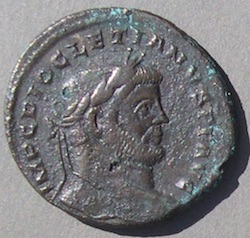 |
 |
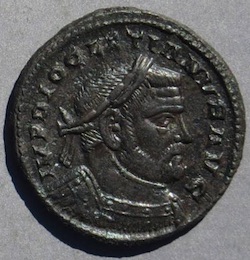 |
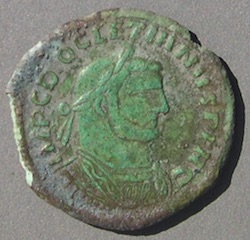 |
| London |
London |
London |
London, ancient imitation |
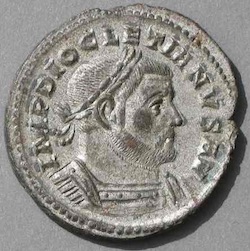 |
 |
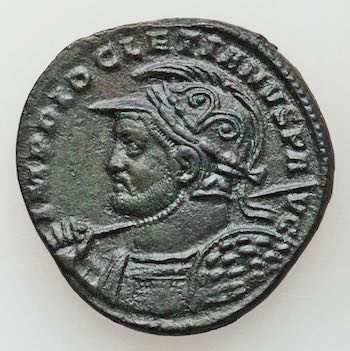 |
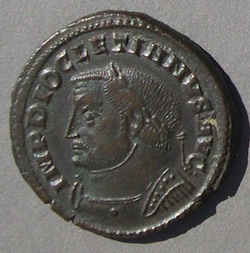 |
| Trier |
Trier |
Trier |
Lyons |
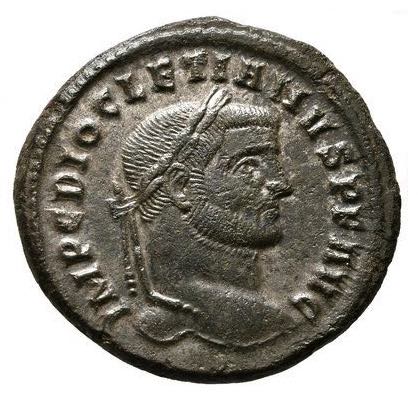 |
 |
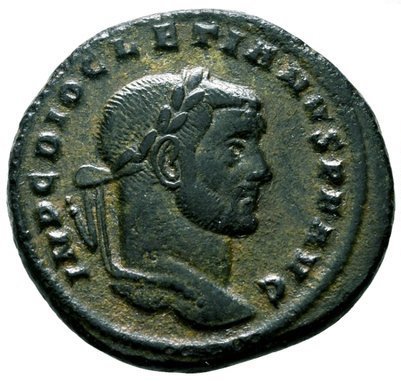 |
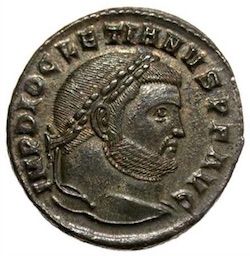 |
| Ticinum |
Aquileia |
Rome |
Siscia |
 |
 |
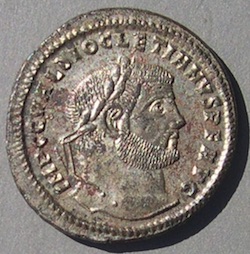 |
 |
| Serdica |
Thessalonica |
Heraclea |
Nicomedia |
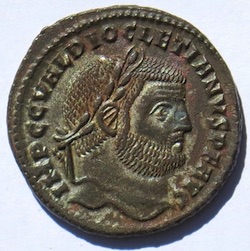 |
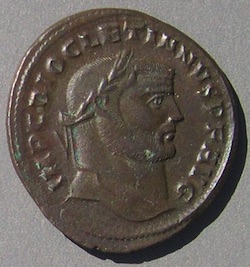 |
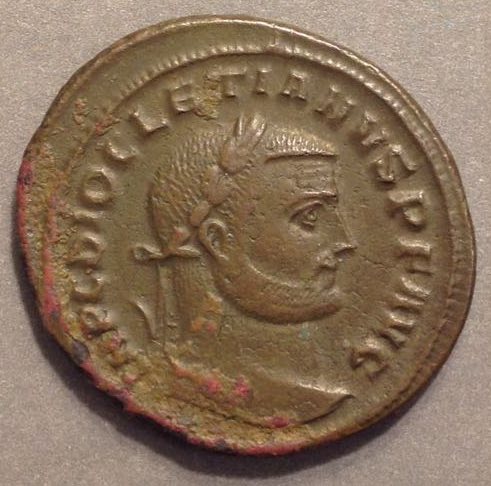 |
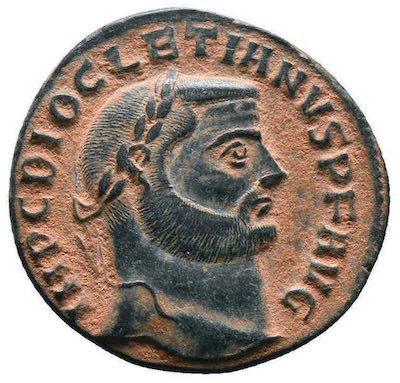 |
| Cyzicus |
Antioch |
Antioch |
Antioch |
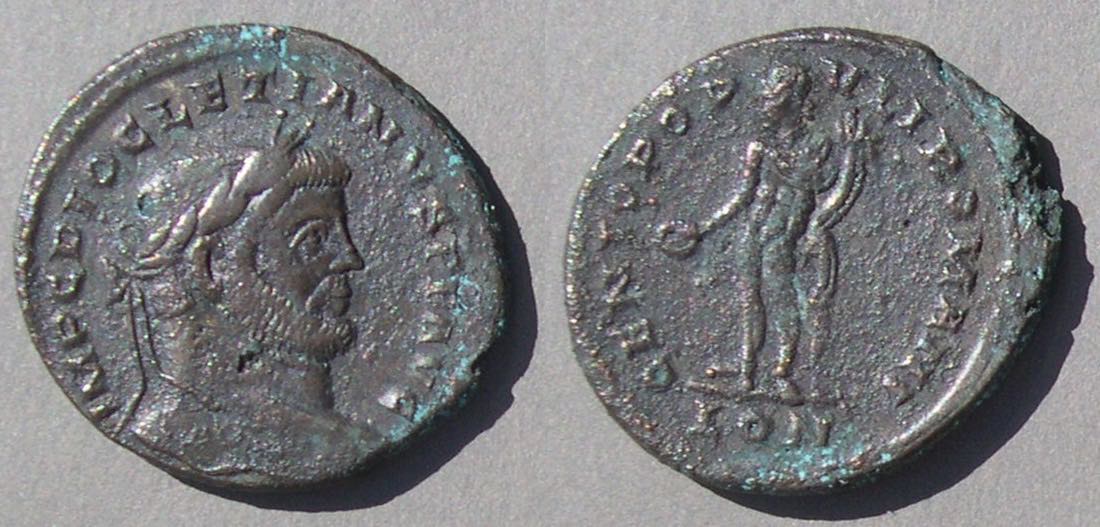 Diocletian
Diocletian
London
28-26 mm. 8.37 grams.
IMP C DIOCLETIANVS PF AVG
LON in exergue
RIC London 1 "c. 297"
Sear 12759
The LON mintmark is rare and commands a large premium.
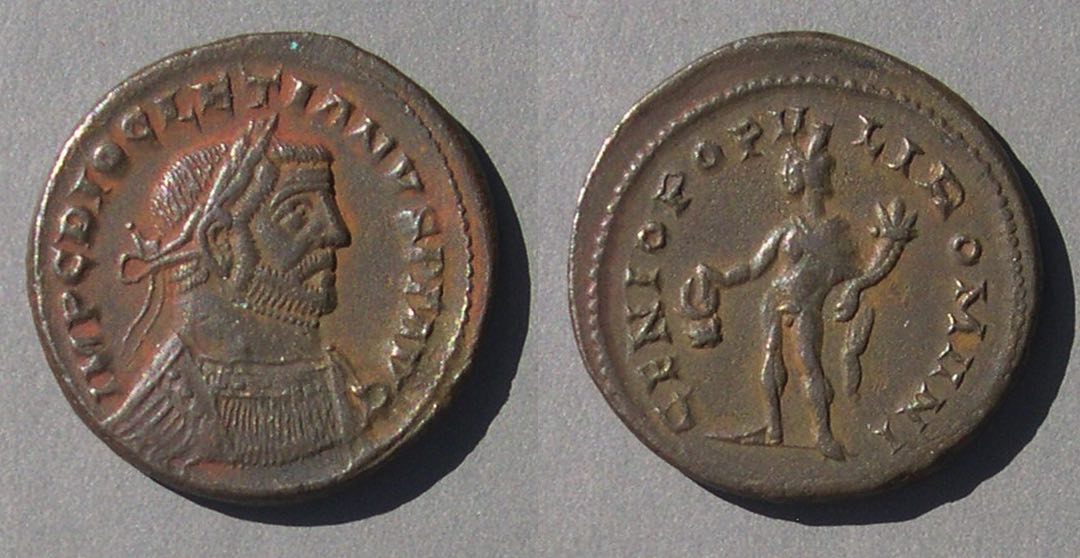 Diocletian
Diocletian
London
27-26 mm. 10.26 grams.
IMP C DIOCLETIANVS PF AVG
nothing in exergue
RIC London 6a "c. 300 onward"
Sear 12760 (small head, long neck)
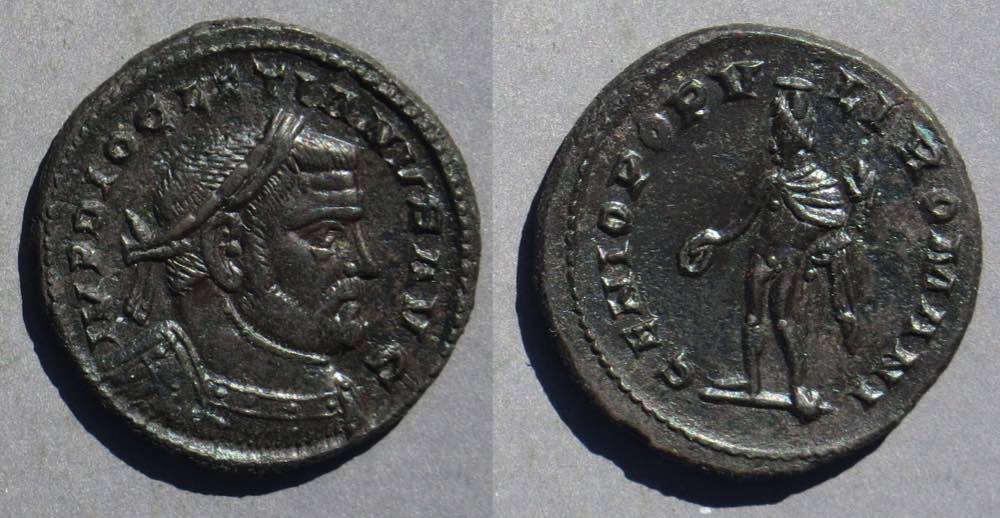 Diocletian
Diocletian
London
28 mm. 10.42 grams.
IMP DIOCLETIANVS AVG
nothing in exergue
RIC London 28a "c. 303 onward"
Sear 12760 (large head, short neck)
 Diocletian
Diocletian
London
26 mm. 4.87 grams. Very light! It is an ancient imitation.
IMP C DIOCLETIANVS PF AG [sic]
I in feld left, II in field right
nothing in exergue
Prototype, except for the "II" fieldmark: RIC London 6a "c. 300"
Prototype Sear 12760
London does not have field marks until c. 310, well after this reverse legend was discontinued and well after it had mintmarks in the exergue.

Diocletian
Trier
27-26 mm. 9.23 grams.
IMP DIOCLETIANVS AVG
S in left field, F in right field
IITR in exergue
RIC Trier 524a "c. 302-303"
Sear 12762
 Diocletian
Diocletian
Trier
27 mm. 9.86 grams.
IMP DIOCLETIANVS AVG
S in feld left, F in field right
PTR in exergue
RIC Trier 582a "c. 303-1 May 305"
Sear 12763
 Diocletian
Diocletian
Trier.
26 mm. 8.40 grams.
IMP DIOCLETIANVS P AVG
B in left field, * in right field
TR in exergue
RIC Trier --, cf. p. 184ff where it has combination 1h/Z,
where Z is listed only for Maximian and Constantius. The series is numbers 264-373, struck "298-9".
Sear -- but close to 12764
The helmeted bust left commands a substantial premium.
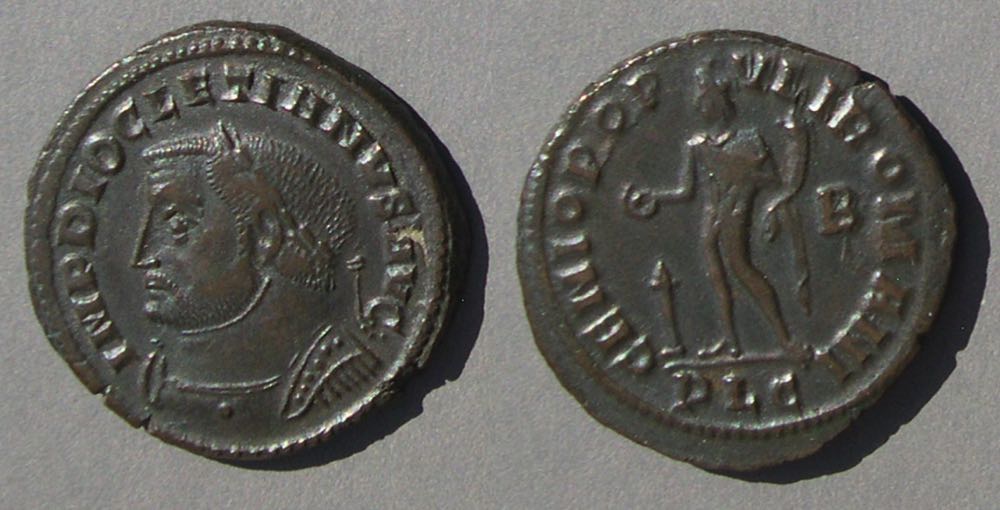 Diocletian
Diocletian
Lugdumum = Lyons
29 mm. 9.90 grams.
IMP DIOCLETIANVS AVG
altar left, B in right field
PLG in exergue
RIC Lyons 113a "c. 301-302"
Sear --, bust left variety of 12768
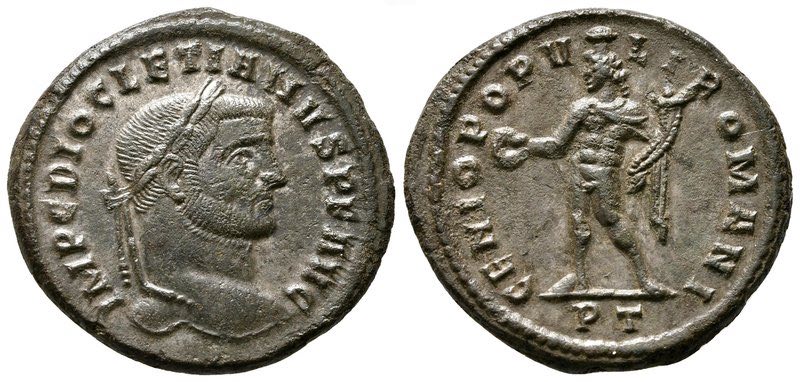
Diocletian
Ticinum
28-26 mm. 8.40 grams.
IMP C DIOCLETIANVS PF AVG
PT in exergue.
RIC Ticinum 29a, "c. 295-6"
Sear 12772
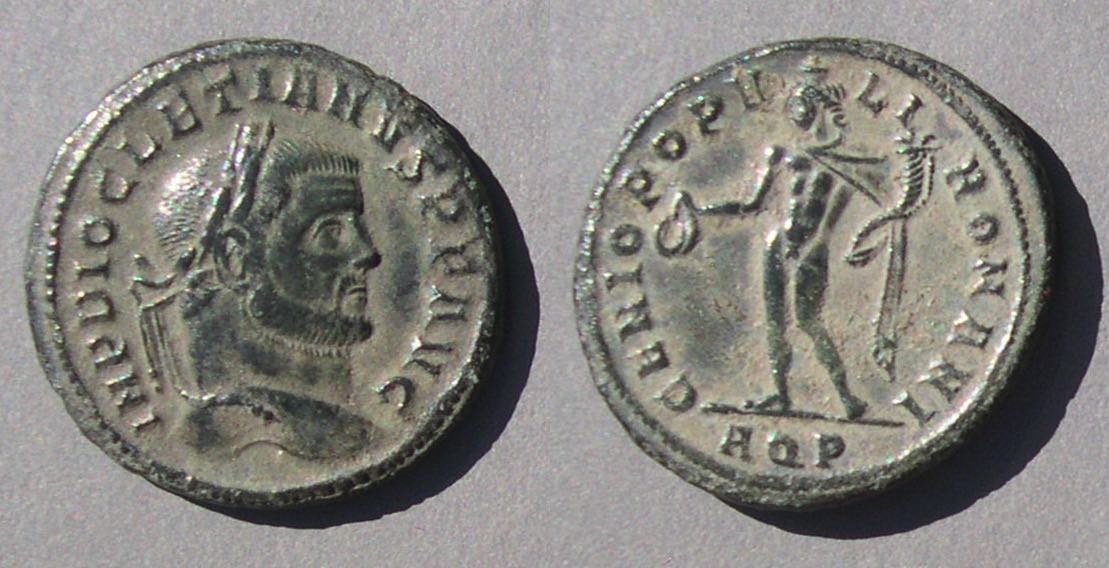 Diocletian
Diocletian
Aquileia
28 mm. 10.15 grams.
IMP DIOCLETIANVS PF AVG
AQP in exergue
RIC Aquileia 23a "c. 296"
Sear 12774
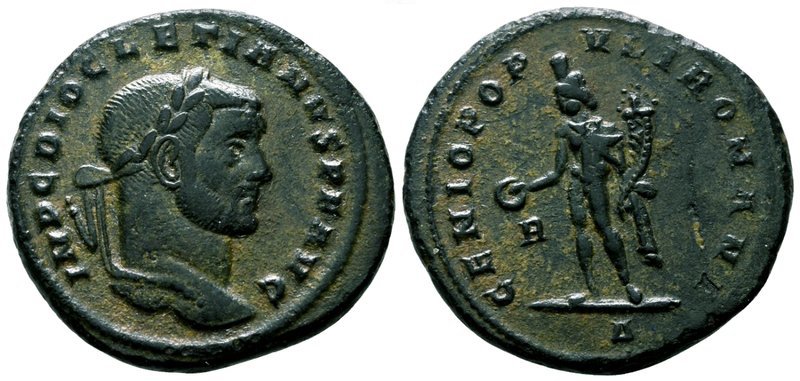 Diocletian
Diocletian
Rome
27-25 mm. 8.33 grams.
IMP C DIOCLETIANVS PF AVG
R in field left
Δ in exergue
RIC Rome 64a "c.296-7"
Sear 12775
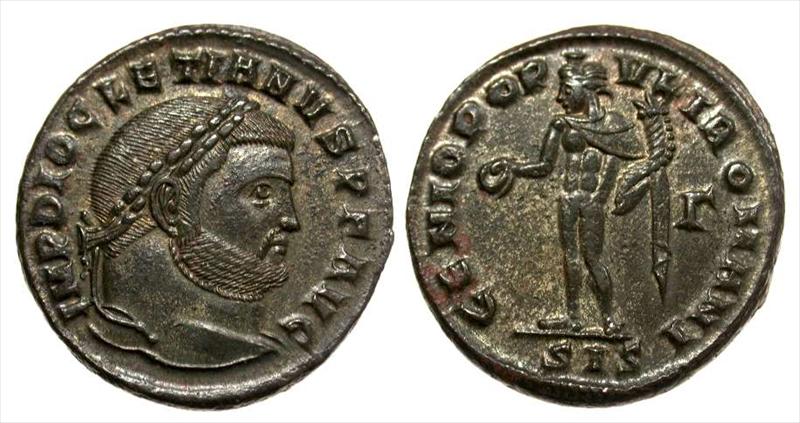
Diocletian
Siscia
27-26 mm. 10.24 grams.
IMP DIOCLETIANVS PF AVG
Γ in field right
SIS in exergue
RIC Siscia 108a "c. 299"
Sear 12780
 Diocletian
Diocletian
Serdica
26 mm. 9.87 grams.
IMP C C VAL DIOCLETIANVS PF AVG
•SM•SD•
RIC Serdica 3a "c.303/4-5"
The Serdica mint opened as the result of the closing of the Thessalonica mint c. 303. [RIC p. 486] It had only this one issue before Diocletian retired.
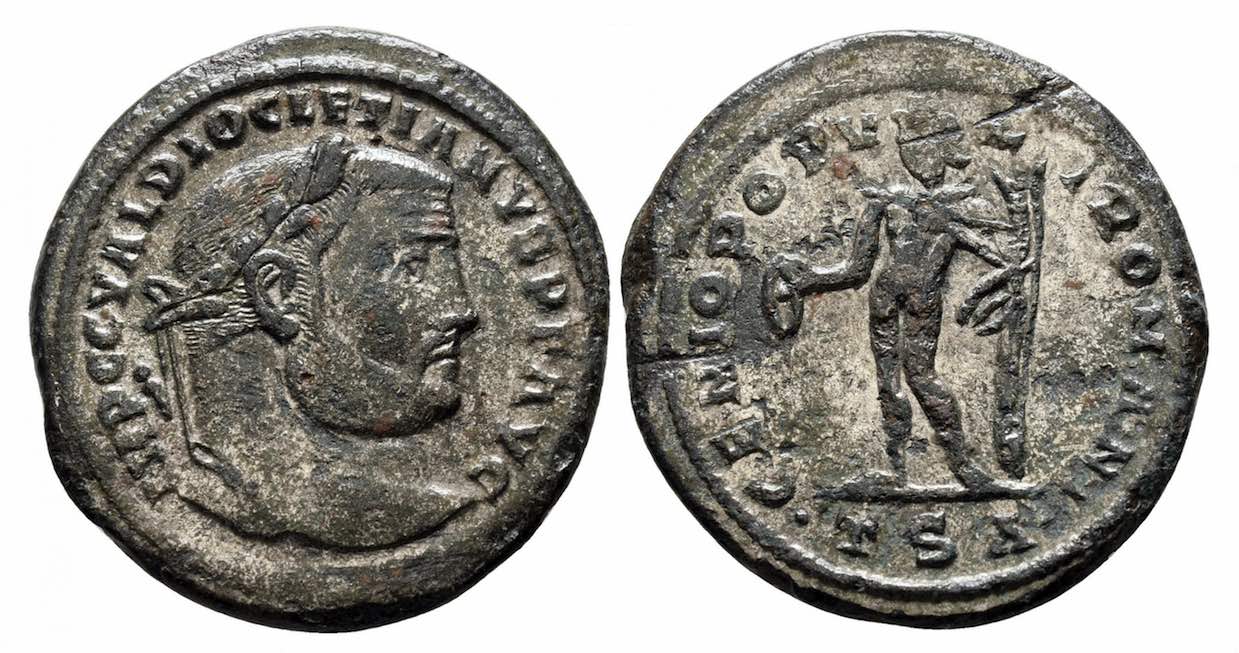
Diocletian
Thessalonica
28-27 mm. 9.17 grams
IMP C C VAL DIOCLETIANVS PF AVG
•TSA• in exergue
RIC Thessalonica 21a "c. 300-1"
Sear IV 12784

Diocletian
Heraclea
28 mm. 10.59 grams.
HTΓ in exergue
RIC Heraclea 17a "c. 296-297"
Sear 12787
Diocletian
Cyzicus
27 mm. 9.78 grams.
KΓ in exergue
RIC Cyzicus 12a "c.295-296"
Sear 12791
Diocletian
Antioch
27 mm. 9.54 grams.
K in left field, B over V in right field
ANT in exergue
RIC Antioch 54a "c. 300-301"
Sear 12795
Diocletian
Antioch
28-26 mm. 9.52 grams.
Stars in lower and upper left field, crescent over Є in right field
ANT in exergue
RIC Antioch 50a "c. 298"
Sear 12797
Diocletian
Antioch
26-25 mm. 8.21 grams
B in right field
ANT in exergue
RIC Antioch 52a "c. 299-300"
Diocletian, issued by Domitius Domitianus
Alexandria
26-24 mm. 8.92 grams.
eagle at feet left, A in right field
ALE in exergue
RIC Alexandria 18a "c. 295-296"
Sear 12801
During the revolt of Domitius Domitianus at Alexandria he issued this type in his own name and in the names of the four tetrarchs. They are distinguished by the eagle.
 Diocletian
Diocletian
Alexandria
28 mm. 11.04 grams.
XX in left field, A over I in right field
ALE in exergue
RIC Alexandria 32a "c. 301"
Sear 12803
The revival of the mark "XXI" suggests Diocletian's Edict of Maximum Prices was accompanied by an attempt to assure the people that the coins had the composition introduced by Aurelian, "20 parts copper and one part silver" (nearly 5% silver). Since silver was worth, in the Edict, 80 times the value of copper, every percent mattered to the intrinsic value of the coin.
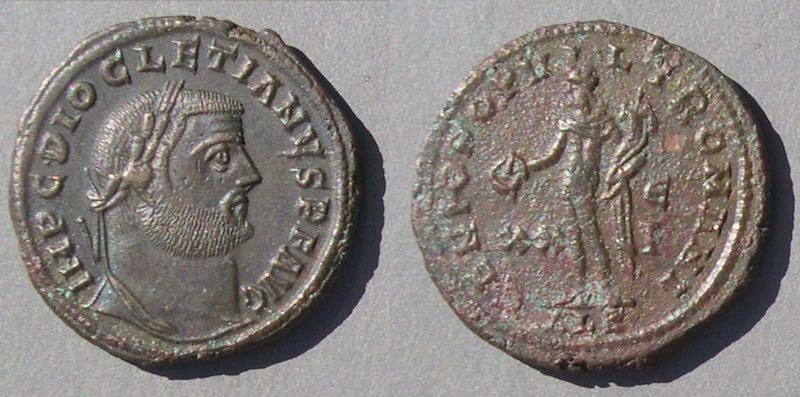 Diocletian
Diocletian
Alexandria
27 mm. 9.43 grams.
XX in left field, Є over I in right field
ALE in exergue
RIC Alexandria 32a "c. 301"
Sear 12803
This coin was analyzed for its silver content by the Physics Department of Montana State University.
(You can see a tiny dull red circle in the right field above the E which was scratched to bare metal and has since toned back some.)
It is 4.0% silver and 93.3% copper and 1.9% tin. The original surface silvering (now absent) would have added about 1% to the total, making it very close the nearly 5% expected from the XXI mark.
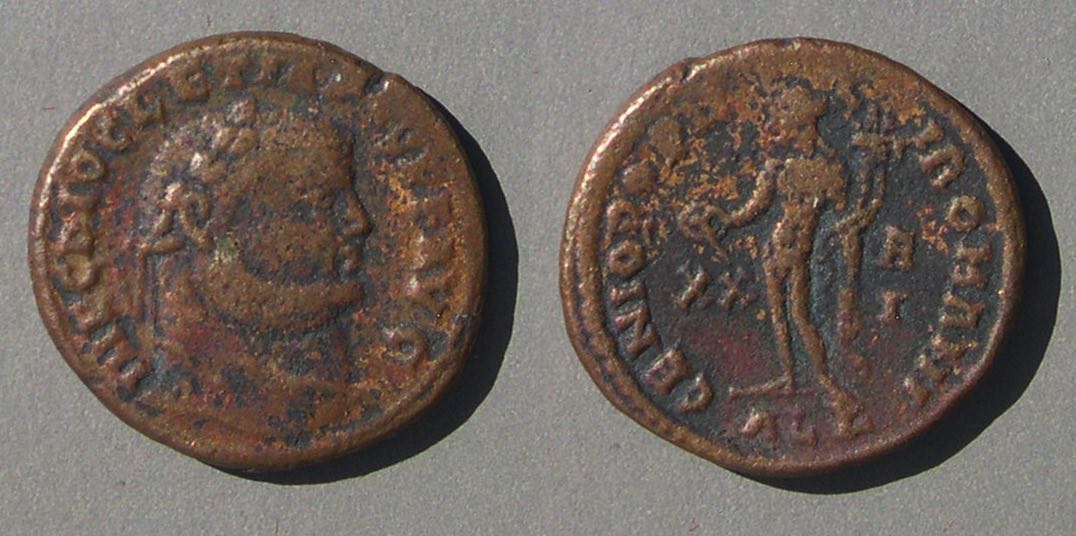 Diocletian
Diocletian
Alexandria, ancient cast imitation
25 mm. 9.42 grams. (Casts tend to be smaller than the original.)
XX in left field, B over I in right field
ALE in exergue
RIC Alexandria 32a "c. 301"
Prototype Sear 12803
Note: RIC makes a distinction between a "modius on head" 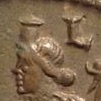 and a "head towered"
and a "head towered"  . Often the headdress is somewhere in between these examples and it is so hard to draw the line that I have decided not to attempt to make the distinction. It is not obvious it is an meaningful difference.
. Often the headdress is somewhere in between these examples and it is so hard to draw the line that I have decided not to attempt to make the distinction. It is not obvious it is an meaningful difference.
Go to a page of folles of Maximian, Constantius, Galerius, or other rulers.
Go to a page of antoniniani (aureliani) of Diocletian and the other tetrarchs.
Go to a page of links to pages about coins of the tetrarchies.
Go to the Table of Contents of this educational site.
 GENIO POPVLI ROMANI
GENIO POPVLI ROMANI 



















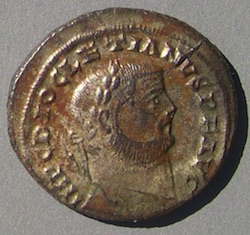
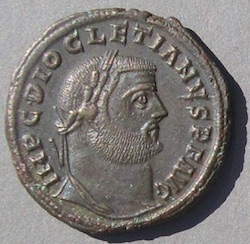
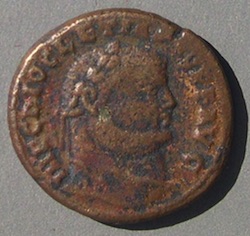
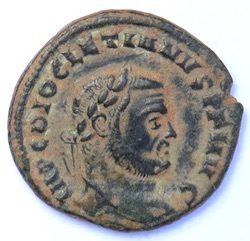















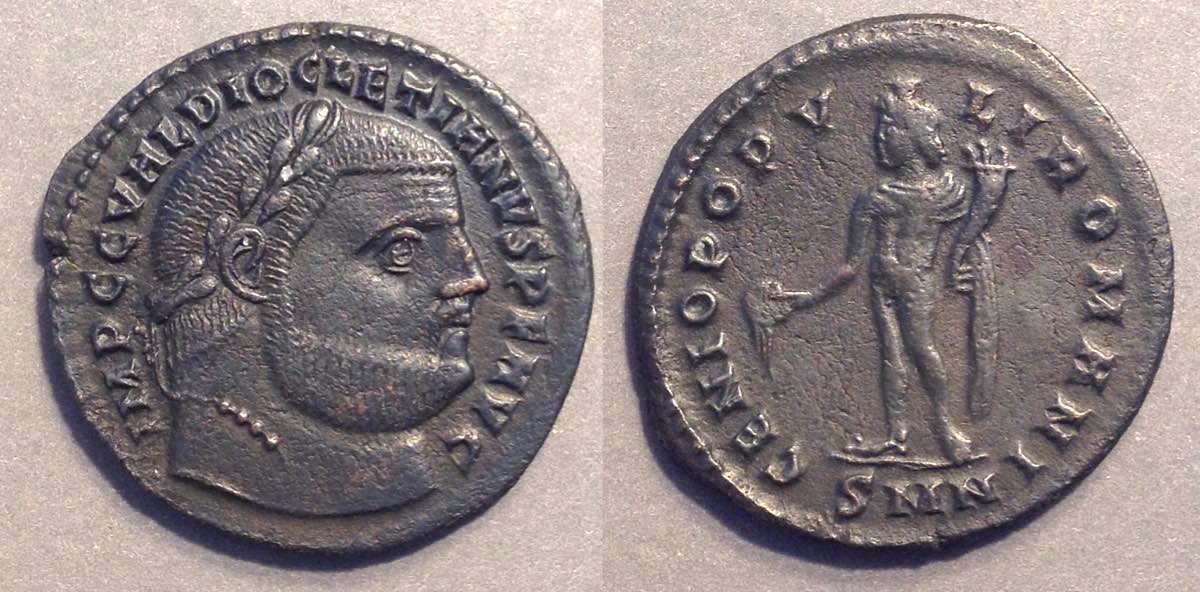
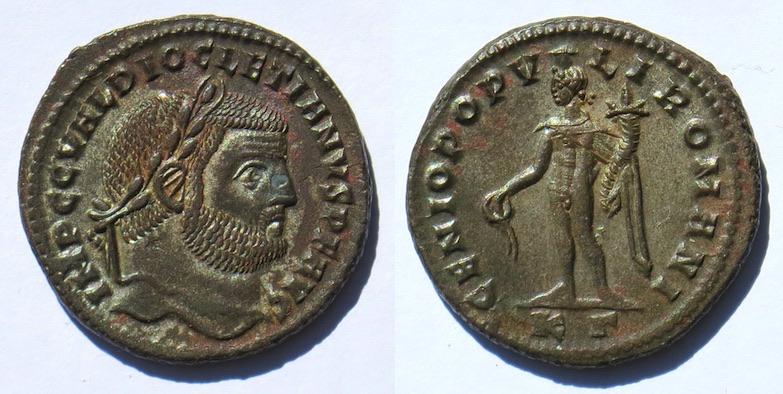
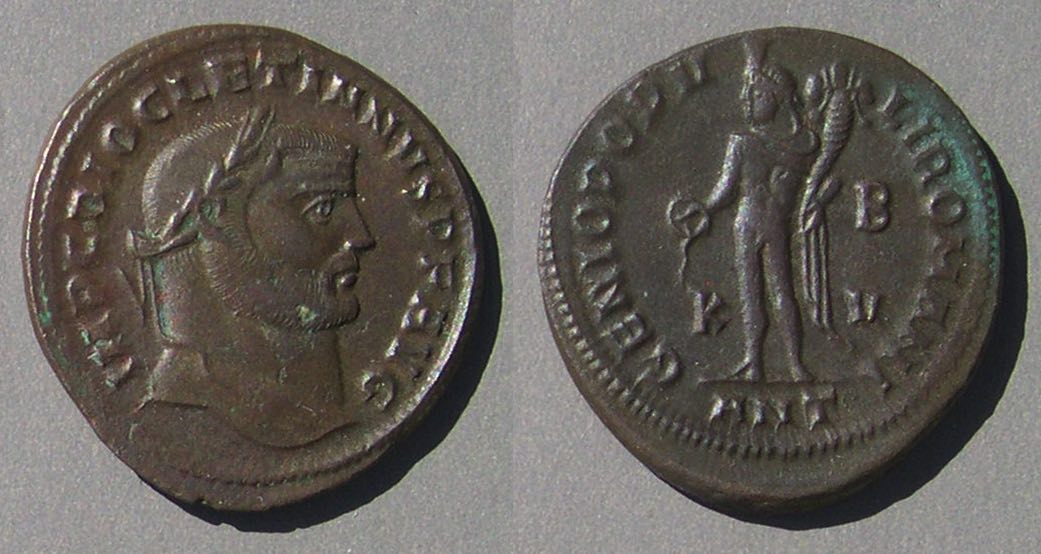
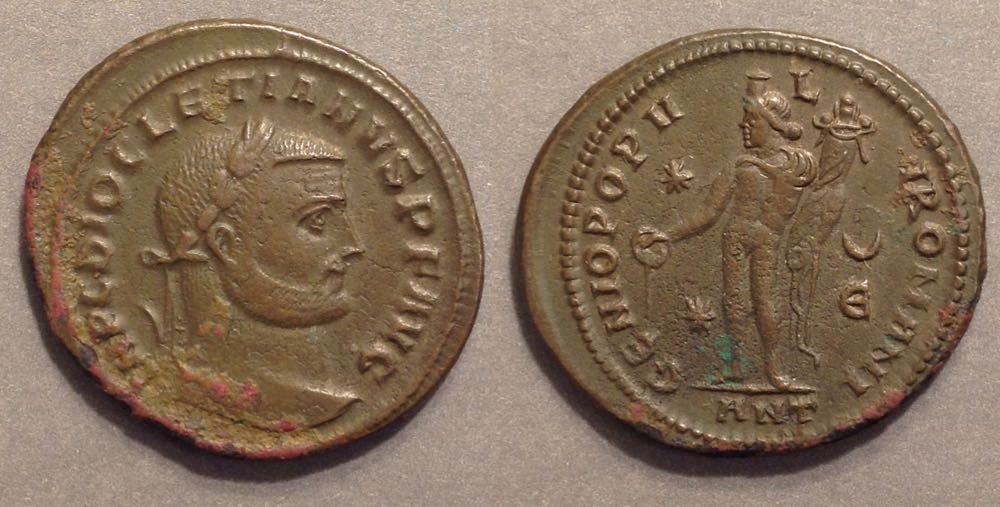
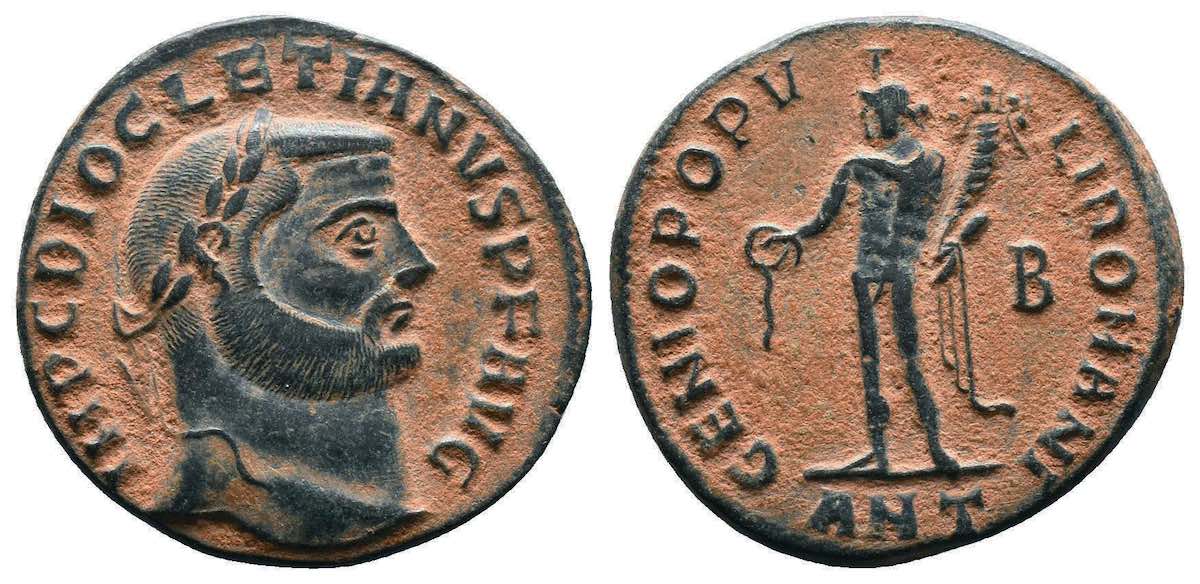
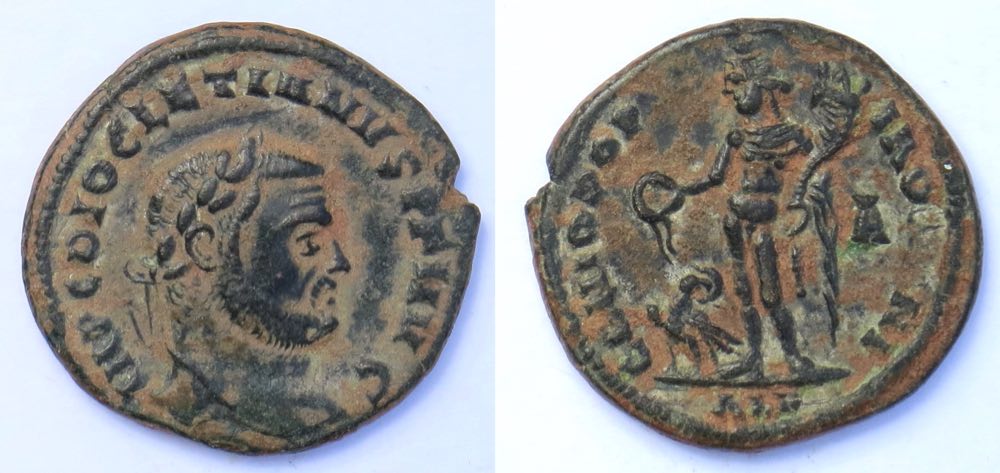



 and a "head towered"
and a "head towered"  . Often the headdress is somewhere in between these examples and it is so hard to draw the line that I have decided not to attempt to make the distinction. It is not obvious it is an meaningful difference.
. Often the headdress is somewhere in between these examples and it is so hard to draw the line that I have decided not to attempt to make the distinction. It is not obvious it is an meaningful difference.